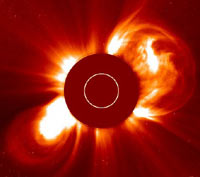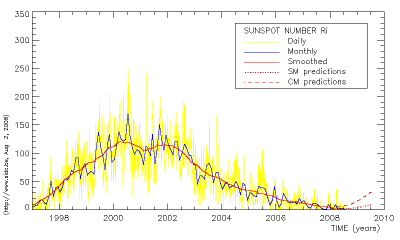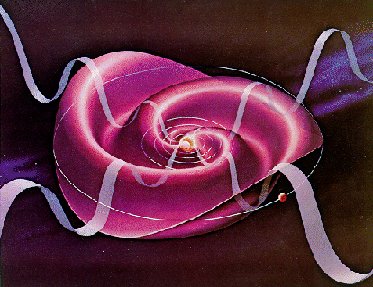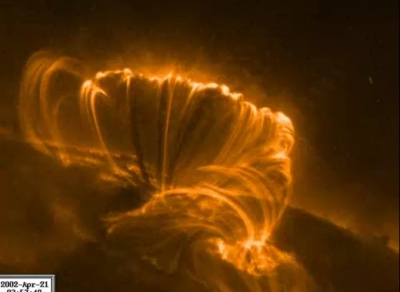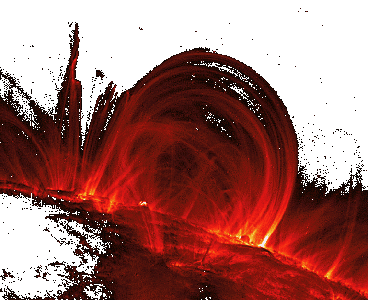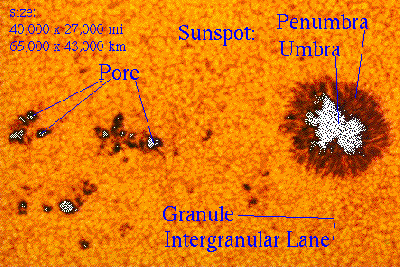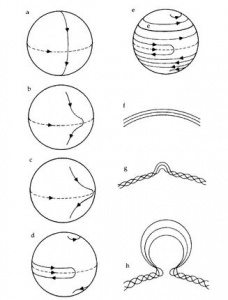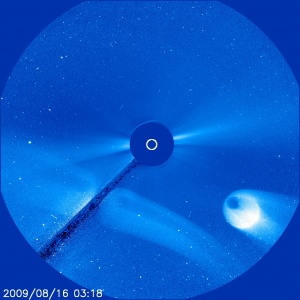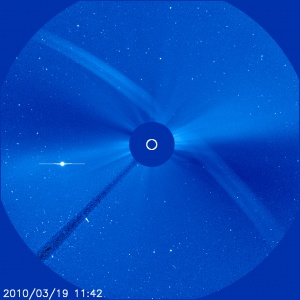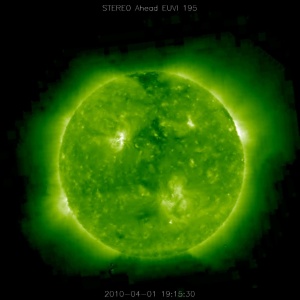Difference between revisions of "911:Plasma cosmos"
Commendatori (talk | contribs) (Blanked the page) |
Commendatori (talk | contribs) |
||
| Line 1: | Line 1: | ||
=[[w:Sun|Sun]]= | |||
* Is the sun actually a [[w:ball of lightning|ball of lightning]]? Problems with the current model of the sun as continuous fusion reaction, releasing energy from the core [http://www.kronia.com/electric.html]: | |||
** Missing [[w:neutrinos|neutrinos]]: | |||
*** "[http://www.nowpublic.com/tech-biz/are-neutrons-simply-electrically-compressed-hydrogen-atoms Are Neutrons Simply Electrically-Compressed Hydrogen Atoms?]" | |||
*** According to conventional Solar theory: "Solar neutrinos originate from the nuclear fusion powering the sun and other stars. The details of the operation of the sun are explained by the [[w:Standard Solar Model|Standard Solar Model]]. In short: when four [[w:proton|protons]] fuse to become one helium nucleus, two of them have to convert into [[w:neutron|neutrons]], and each such conversion releases one electron neutrino." [http://en.wikipedia.org/wiki/Neutrinos] | |||
** Temperature of the halo-like [[w:Corona|corona]] is 300 times than that of the surface. | |||
** Rotates faster at equator, faster on surface. | |||
** Solar wind accelerates upon leaving the Sun. | |||
** Sunspots reveal cooler interior. | |||
** Sunspots travel faster than surrounding surface. | |||
** Sunspot penumbra (interior walls) reveal structured filaments. | |||
* See also: | |||
** '''[[911:Plasma_cosmos#Star_structure|Star structure]]''' | |||
** '''[[911:Plasma_cosmos#Solar_data|Solar data]]''' | |||
** '''[[911:Occult_symbolism_II#Sun|Occult symbolism: Sun]]''' | |||
** [http://www.thunderbolts.info/forum/phpBB3/viewtopic.php?f=4&t=1615 Thunderbolts forum: Solar model] | |||
** "[http://www.binaryresearchinstitute.org/bri/research/update.shtml Is the Sun part of a binary star system?]" | |||
** video: [http://www.youtube.com/watch?v=rY4JDY5U-FU 2009 timelapse of Sun by Satellite A] | |||
** video: [http://www.youtube.com/watch?v=qyNVdsBenqU 2009 timelapse of Sun by Satellite B] | |||
* Solar concepts: | |||
<gallery widths="400px" heights="300px" perrow="2"> | |||
Image:Sun_corona_002b.jpg|'''[[911:Plasma_cosmos#Corona|Solar corona]] with an overlay of the [[911:Energy#Field flow|EM field flux]]'''<br/><br/>"The above picture is a combination of thirty-three photographs that were digitally processed to highlight faint features of a total eclipse that occurred in March of 2006. The images of the Sun's corona were digitally altered to enhance dim, outlying waves and filaments." [http://apod.nasa.gov/apod/ap090726.html] | |||
Image:Sun_004.jpg|[[911:Plasma_cosmos#Coronal_mass_ejection|Coronal mass ejection]]<br/><br/>'''Note:''' the visible [[911:Plasma_cosmos#Astronomical_dynamics|universal flux field]] with its equatorial expansion powering the CME. [http://www.exploratorium.edu/chaco/HTML/observation4.html] | |||
</gallery> | |||
==Sun trends== | |||
* See also: '''[[911:2012#Sun_intensifying|2012: Sun intensifying]]''' | |||
* [[w:Solar variation|Solar variation]] | |||
** '''[[w:Solar cycle|Solar cycle]]''' (see also: '''[[w:Solar_variation#Solar_cycles|Solar variation: Solar cycles]]''') | |||
*** '''[[w:Solar maximum|Solar maximum]]''': "is the period of greatest solar activity in the solar cycle of the sun. During solar maximum, sunspots appear. Solar maximum is contrasted with solar minimum. Solar maximum is the period when the sun's magnetic field lines are the most distorted due to the magnetic field on the solar equator rotating at a slightly faster pace than at the solar poles. The sun takes about 11 years to go from one solar maximum to another and 22 years to complete a full cycle (where the magnetic charge on the poles is the same)." | |||
*** '''[[w:Solar minimum|Solar minimum]]''': "is the period of least solar activity in the solar cycle of the sun. During this time, sunspot and solar flare activity diminishes, and often does not occur for days at a time. The date of the minimum is described by a smoothed average over 12 months of sunspot activity, so identifying the date of the solar minimum usually can only happen 6 months after the minimum takes place. Solar minimum is contrasted with the solar maximum, where there may be hundreds of sunspots." | |||
* "In the electrical model '''the sunspot cycle is most likely a result of fluctuations in the electrical power supply from the local arm of our galaxy.''' As the varying current density and magnetic fields of huge Birkeland current filaments slowly rotate past our solar system, they apply more or less power to the electrical circuit that lights up our daytime sky. Rather than a weak Sun, the lack of sunspots here at the beginning of Solar Cycle 24 is most likely due to a weaker current flow through the galaxy." [http://geoplasma.spaces.live.com/blog/cns!C00F2616F39D0B2B!710.entry] | |||
* See also: | |||
** "[http://wattsupwiththat.wordpress.com/2008/02/13/where-have-all-the-sunspots-gone/ Where have all the sunspots gone?]" | |||
** "[http://wattsupwiththat.wordpress.com/2008/01/04/solar-cycle-24-has-officially-started/ Solar Cycle 24 has officially started]" | |||
** "[http://science.nasa.gov/headlines/y2007/14dec_excitement.htm Is a New Solar Cycle Beginning?]" | |||
** [http://ourworld.compuserve.com/homepages/jbstoneking/kotovpg1.htm Solar pulsation] (V. A. Kotov and S. Koutchmy, 1985) | |||
** "[http://spd.boulder.swri.edu/solar_mystery/ Mystery of the Missing Sunspots, Solved?]" | |||
{{sun-trends}} | |||
<!-- | |||
* Latest solar developments: | |||
<gallery widths="400px" heights="300px" perrow="2"> | |||
Image:Sunspot_2008-9__2009-1.gif|Most of the "Cycle 24" (which follows after Cycle 23) sunspots between Sept 2008 and Jan 2009 [http://solarcycle24com.proboards106.com/index.cgi?board=archive&action=display&thread=366] | |||
Image:Sunspot_2008-06-28-1600.gif|2008-06-28 [http://wattsupwiththat.wordpress.com/2008/06/28/sun-still-quiet-over-two-months-since-a-cycle-24-spot-seen/] | |||
Image:Sunspot_2008-10-14.png|2008-10-14 [http://sidc.oma.be/uset/index.php] <br/><br/>[http://www.boston.com/bigpicture/2008/10/the_sun.html The Boston Globe article] on October 13, 2008: "The Sun is now in the quietest phase of its 11-year activity cycle, the solar minimum - in fact, it has been unusually quiet this year - with '''over 200 days so far with no observed sunspots. The solar wind has also dropped to its lowest levels in 50 years.''' Scientists are unsure of the significance of this unusual calm, but are continually monitoring our closest star with an array of telescopes and satellites. Seen below are some recent images of the Sun in more active times." | |||
Image:Sunspot_2008-12-19.png|2008-12-19 | |||
Image:Sunspot_2009-07-11.jpg|2009-07-11<br/><br/>"'''For the first time in two years the surface of the sun has become active, culminating in a mass of huge solar flares on Sunday.''' ... Two years ago there was a single massive explosion, but since then there has not been much activity on the sun," [http://www.finda.com.au/story/2009/07/07/suns-surface-flares-up/] <br/><br/>"'''Astronomers are claiming that Earth is witnessing the biggest and most powerful sunspot ever seen and the sunspot is yet to peak in intensity.''' ... '''The size of a sunspot varies, ranging from the size of the moon to 65 times larger than the size of earth and lasts for about a month then fades away. This newest sunspot is thought to be 60 to 80 times the size of Earth''' and has occurred on the side of the sun, which is in view of Australia. Wappa Falls Observatory head astronomer Owen Bennedick describes the sunspot shape like the letter S and thinks it to be approximately 150,000 km long and 30,000 km wide. “It's flares have not yet been measured,” Owen Bennedick said, “but it is like hundreds of thousands of hydrogen bombs.” '''The flares have been so bright that NASA has had trouble taking accurate pictures of the sunspot.''' Mr Bennedick said the sunspot is still growing in intensity but predicts it could climax by today. ... Sunspots appear on the sun in cycles, occurring every 11 years, '''the current cycle has four years until it reaches it peak.''' The last sunspot happened two years ago and was the most powerful flare yet measuring x28. Most sunspot flares measure around x12 which is still considered powerful. The Sunspot two years ago was 45 times larger than the earth and lasted for 45 days." [http://www.gympietimes.com.au/photos/galleries/largest-sunspot-ever/] | |||
Image:Sunspot_2009-07-12.gif|2009-07-12? (see previous) | |||
</gallery --> | |||
==[[w:Corona|Corona]]== | |||
<gallery widths="400px" heights="300px" perrow="2"> | |||
Image:Sun_corona_002b.jpg|'''Solar corona with an overlay of the [[911:Energy#Field flow|field flow]]'''<br/><br/>"The above picture is a combination of thirty-three photographs that were digitally processed to highlight faint features of a total eclipse that occurred in March of 2006. The images of the Sun's corona were digitally altered to enhance dim, outlying waves and filaments." [http://antwrp.gsfc.nasa.gov/apod/astropix.html] | |||
Image:Sun_corona_001.jpg|A visible solar corona during a [[w:Solar eclipse|Solar eclipse]] (August 11, 1999, France). [http://en.wikipedia.org/wiki/Corona] | |||
Image:Sun_007.jpg|To research: solar temperature claims<br/><br/>'''Note:''' Forum comment: "The positively imploding electrical currents produce roaring flame like appearances in the Sun's upper atmosphere. '''The Sun is an electro-magnetic plasma sphere and the space surrounding it is freezing cold, not millions of degrees as is also claimed''' in academic theories based on nuke fusion theory that has been utterly debunked to it's core." [http://www.youtube.com/watch?v=2GXQWTKGnz0]<br/><br/>The diagram is showing the rising temperature from the '''[[w:photosphere|photosphere]]''' (varying from 4.000 to 6.400 [[w:Kelvin|Kelvin]], with a current average of about 5.800K), to the '''[[w:chromosphere|chromosphere]]''' (4.500 to as high as 20.000 Kelvin) to the '''[[w:corona|corona]]''' (temperature from 1.000.000 up to 10.000.000 Kelvin). | |||
Image:Sun_005.jpg|'''[[w:Heliospheric current sheet|Heliospheric current sheet]]''' - The solar electro-magnetic vortex, which is also named the [[w:Parker spiral|Parker spiral]]. | |||
Image:Sun_001.jpg | |||
</gallery> | |||
==[[w:Solar flare|Solar flare]]== | |||
* "A '''[[w:solar flare|solar flare]]''' is an explosion on the Sun that happens when energy stored in twisted magnetic fields (usually above sunspots) is suddenly released. Flares produce a burst of radiation across the electromagnetic spectrum, from radio waves to x-rays and gamma-rays. Scientists classify solar flares according to their x-ray brightness in the wavelength range 1 to 8 Angstroms. There are 3 categories: X-class flares are big; they are major events that can trigger planet-wide radio blackouts and long-lasting radiation storms. M-class flares are medium-sized; they can cause brief radio blackouts that affect Earth's polar regions. Minor radiation storms sometimes follow an M-class flare. Compared to X- and M-class events, C-class flares are small with few noticeable consequences here on Earth." [http://spaceweather.com/glossary/flareclasses.html] | |||
<gallery widths="400px" heights="300px" perrow="2"> | |||
Image:Solar_x_flare_001.jpg|X-class solar flare on 2002-04-21 ([http://www.youtube.com/watch?v=bYaBU1XfmS4 video]) | |||
Image:Solar_prominence_001.gif | |||
</gallery> | |||
===[[w:Coronal mass ejection|Coronal mass ejection]]=== | |||
* If a [[911:Plasma_cosmos#Solar_flare|solar flare]] is exceptionally powerful, it can cause coronal mass ejections (CME). A coronal mass ejection is '''an ejection of material''' from the [[911:Plasma_cosmos#Corona|solar corona]], usually observed with a white-light [[w:Coronagraph|coronagraph]]. The ejected material is a '''plasma (containing small quantities of heavier elements such as helium, oxygen, and iron)''', plus the entraining [http://www.mps.mpg.de/meetings/ccmag/ coronal magnetic field]. | |||
* See also: | |||
** '''[[911:Plasma_cosmos#Planetary_birth|Planetary birth]]''' | |||
<gallery widths="400px" heights="300px" perrow="2"> | |||
Image:Sun_004.jpg|Coronal mass ejection<br/><br/>'''Note the visible [[911:Plasma_cosmos#Astronomical_dynamics|universal flux field]] with its equatorial expansion powering the CME.''' [http://www.exploratorium.edu/chaco/HTML/observation4.html] | |||
Image:Solar_tsunami_001.gif|Coronal mass ejection (frontal and side view)<br/><br/>"Solar tsunamis are real. The twin [http://stereo.gsfc.nasa.gov/ STEREO] spacecraft confirmed their reality in February 2009 when sunspot 11012 unexpectedly erupted. The blast hurled a billion-ton cloud of gas (a "CME") into space and sent a tsunami racing along the sun's surface. STEREO recorded the wave from two positions separated by 90o, giving researchers an unprecedented view of the event. (...) The technical name is "fast-mode magnetohydrodynamical wave"—or "MHD wave" for short. The one STEREO saw reared up about 100,000 km high, and raced outward at 250 km/s (560,000 mph) packing as much energy as 2400 megatons of TNT (1029 ergs). Solar tsunamis were discovered back in 1997 by the Solar and Heliospheric Observatory (SOHO). In May of that year, a CME came blasting up from an active region on the sun's surface, and SOHO recorded a tsunami rippling away from the blast site." [http://science.nasa.gov/headlines/y2009/24nov_solartsunami.htm?list185042] | |||
Image:Sun_004.gif|[http://ircamera.as.arizona.edu/NatSci102/lectures/sun.htm] | |||
</gallery> | |||
===[[w:Solar prominence|Solar prominence]]=== | |||
* "A '''[[w:Solar prominence|solar prominence]]''' is a large bright feature extending outward from the Sun's surface, often in a loop configuration. Prominences are anchored to the Sun's surface in the photosphere, and extend outwards into the Sun's corona. While the corona consists of extremely hot ionized gases, known as plasma, which do not emit much visible light, prominences contain much cooler plasma, similar in composition to that of the chromosphere. A prominence forms over timescales of about a day, and stable prominences may persist in the corona for several months. Some prominences break apart and give rise to [[911:Plasma_cosmos#Coronal_mass_ejection|coronal mass ejections]]." [http://en.wikipedia.org/wiki/Solar_prominence] | |||
<gallery widths="400px" heights="300px" perrow="2"> | |||
Image:Sun_006.jpg|Elements of the Sun's [[w:photosphere|photosphere]]. [http://ircamera.as.arizona.edu/NatSci102/lectures/sun.htm] | |||
Image:Solar_prominence_2008-09-29.jpg|solar prominence eruption on September 29, 2008 [http://en.wikipedia.org/wiki/File:Solar_prominence_from_STEREO_spacecraft_September_29,_2008.jpg] | |||
Image:Sun_002.png | |||
Image:CME_spiral_001.jpg|A (previously fully circular - now 'breaking up') twisting, helical-shaped [[911:Plasma_cosmos#Sun|Solar]] prominence. (see '''[http://www.youtube.com/watch?v=xob6nGAFej8 video]''') | |||
</gallery> | |||
==[[w:Granule (solar physics)|Granules]]== | |||
(todo) | |||
==[[w:Spicule (solar physics)|Spicules]]== | |||
<gallery widths="400px" heights="300px" perrow="2"> | |||
Image:Sunspot_spicules.jpg|'''[[w:Spicule (solar physics)|Spicules]]'''<br/><br/>"Time-sequenced images have recently shown that spicules last about five minutes, starting out as tall tubes of rapidly rising gas but eventually fading as the gas peaks and falls back down to the Sun. These images also indicate, for the first time, that the ultimate cause of spicules is sound-like waves that flow over the Sun's surface but leak into the Sun's atmosphere." [http://balancer.ru/2005/04/29/post-545259.html] | |||
</gallery> | |||
==[[w:Sunspot|Sunspots]]== | |||
* The sunspot can be divided into two parts: | |||
** The '''central [[w:umbra|umbra]]''', which is the darkest part, where the magnetic field is approximately vertical. | |||
** The '''surrounding [[w:penumbra|penumbra]]''', which is lighter, where the magnetic field lines are more inclined. | |||
* Various notes: | |||
** "[http://spaceweather.com/glossary/sunspotnumber.html Sunspot Numbers]" | |||
** [[w:Babcock Model|Babcock Model]] (?) | |||
** Why is the Sunspot (and the Sun's internal area under it) colder than the surrounding surface area of the Sun? (See also: [[911:Geometry#Cymatics|Geometry: Cymatics]]) | |||
Sunspot concepts: | |||
<gallery widths="400px" heights="300px" perrow="2"> | |||
Image:Sunspot_000.jpg | |||
Image:Sunspot_000.gif | |||
Image:Sunspot_003.jpg|'''Note the spiraling vortex shape, itself consisting of twisting filaments!''' [http://www.solarphysics.kva.se/NatureNov2002/]<br/><br/>"For conventional theory, sunspot penumbrae remain a mystery: the standard solar model does not predict such structures. The electric model does predict them. '''Electric discharges often appear as long twisting filaments. Because they are funnels of glowing plasma they appear darker in their centers—convection cells would appear darker on their cooler edges.'''" [http://geoplasma.spaces.live.com/blog/cns!C00F2616F39D0B2B!710.entry] | |||
Image:Sunspot_004.jpg|[http://www.solarphysics.kva.se/NatureNov2002/] | |||
Image:Sunspot_005.gif|[http://www.solarphysics.kva.se/NatureNov2002/] | |||
Image:Sunspot_formation_theory_001.jpg|(todo: rewrite in terms of '''cymatical plasma surface harmonics''')<br/><br/>A sunspot formation theory: "Sunspots are formed by twisting lines of magnetic force as the sun's poles rotate slower than the equator. The result of this difference in rotation is a twisting of the lines of force of the sun’s magnetic field. Cotterell’s theory of sunspots, shared by many other scientists, involves seeing the magnetic lines of force on the Sun as though they were “rubber bands” being subject to twisting and intertwining. Some of these “rubber bands” would run North to South, and others East to West. So, as the Equator spins at a faster speed than the poles, so too will the vertical and horizontal lines of magnetic force continue to twist and tangle up into each other like a giant braid. '''When the tension gets too high, there is a sudden snap, releasing the pent-up energy in the form of [[911:Plasma_cosmos#Solar_flare|flares]] and [[911:Plasma_cosmos#Coronal_mass_ejection|CMEs]]. The precursor to this sudden release is a sunspot, which usually shows up in two nearby places at once. These two spots correspond to the two edges of the arc that is created when the magnetic, twisted braid of energy “bulges” out of the Sun.'''" [http://sunlightenment.com/2012-doomsday-or-new-day/] | |||
</gallery> | |||
==[[w:Solar microflares|Solar microflares]]== | |||
* Various notes: | |||
** The region of solar microflares has a strong association with the sunspot regions. | |||
<gallery widths="400px" heights="300px" perrow="2"> | |||
Image:Solar_microflares.jpg|"The heliographic locations of about 25,000 microflares observed by the [[w:Reuven Ramaty High Energy Solar Spectroscopic Imager|RHESSI]] (see also: [http://www.scholarpedia.org/article/Solar_Satellites]) satellite [over a 5 year period]. <br/><br/>'''Note:''' the strong organization into the [[911:Energy#Field_flow|mid-latitude latitude bands]] [centered around the equatorial plane] where sunspots appear. The clustering of points shows that many events typically come from one region, and so the points drift across the disk at about the solar rotation rate" [http://www.scholarpedia.org/article/Solar_activity]<br/><br/>'''Note:''' the similarity with the mid-latitude region of Earth being the most active in [[911:Plasma_cosmos#Lightning|lightning]] strikes (among other weather phenomena). | |||
</gallery> | |||
==[[w:Solar wind|Solar wind]]== | |||
* "The [[w:solar wind|solar wind]] is a stream of charged particles — a plasma — that are ejected from the upper atmosphere of the sun. It consists mostly of [[w:electrons|electrons]] and [[w:protons|protons]] with energies of about 1 [[w:keV|keV]]." [http://en.wikipedia.org/wiki/Solar_wind] | |||
* "'''Geomagnetic storms''' are major disturbances of the magnetosphere that occur when the interplanetary magnetic field turns southward and remains southward for an prolonged period of time. During a geomagnetic storm's main phase, which can last as long as two to two and a half days in the case of a severe storm, charged particles in the near-Earth plasma sheet are energized and injected deeper into the inner magnetosphere, producing the storm-time ring current. This phase is characterized by the occurrence of multiple intense substorms, with the attendant auroral and geomagnetic effects. (The nature of the relationship between magnetic storms and substorms is a matter of some controversy.) When the interplanetary field turns northward again, the rate of plasma energization and inward transport slows and the various loss processes that remove plasma from the ring current can begin to restore it to its pre-storm state. In the case of a great storm, such as the one of 6 February 1986, the ring current can take over a month to fully return to its quiet state. The drop in the surface magnetic field strength during the main phase of a geomagnetic storm is typically preceded by a brief rise in the field strength (see the entry for Dst index). This increase is caused by an intensification of the magnetopause current that occurs as increased solar wind dynamic pressure drives the magnetopause inward by as much as four Earth radii. This phenomenon, which is known as the "Storm Sudden Commencement" (SSC), marks the beginning of the initial phase of the storm. '''Geomagnetic storms are classified as recurrent and non-recurrent. Recurrent storms occur every 27 days, corresponding to the Sun's rotation period.''' They are triggered by the Earth's encounters with the southward- oriented magnetic field of the high-pressure regions formed in the interplanetary medium by the interaction of low- and high-speed solar wind streams co-rotating with the Sun. '''Recurrent storms occur most frequently in the declining phase of the solar cycle. Non-recurrent geomagnetic storms, on the other hand, occur most frequently near solar maximum.''' They are caused by interplanetary disturbances driven by fast coronal mass ejections (CMEs) and typically involve an encounter with both the interplanetary shock wave and the CME that drives it." [http://pluto.space.swri.edu/IMAGE/glossary/geomagnetic_storm.html] | |||
<gallery widths="400px" heights="300px" perrow="2"> | |||
Image:solar_wind_comet_tail.jpg|Comet collision with solar wind. See the [http://wikicompany.org/wiki/Image:Solar_wind_comet_001.gif animated version here].<br/><br/>"NASA's STEREO satellite captured the first images ever of a collision between a solar "hurricane", called a [[w:coronal mass ejection|coronal mass ejection]] (CME), and a comet on April 4, 2007. '''The collision caused the complete detachment of the comet's plasma tail'''." [http://www.boston.com/bigpicture/2008/10/the_sun.html] | |||
</gallery> | |||
<span id="Sun anomalies"> | |||
==Solar anomalies== | |||
* To research: Are some of the images below a carefully crafted [[911:New_Age_agenda|New Age agenda]] hoax, or visual traces of real cosmic events? | |||
{{solar-anomaly-images}} | |||
Revision as of 01:03, 24 March 2011
Sun
- Is the sun actually a ball of lightning? Problems with the current model of the sun as continuous fusion reaction, releasing energy from the core [33]:
- Missing neutrinos:
- "Are Neutrons Simply Electrically-Compressed Hydrogen Atoms?"
- According to conventional Solar theory: "Solar neutrinos originate from the nuclear fusion powering the sun and other stars. The details of the operation of the sun are explained by the Standard Solar Model. In short: when four protons fuse to become one helium nucleus, two of them have to convert into neutrons, and each such conversion releases one electron neutrino." [34]
- Temperature of the halo-like corona is 300 times than that of the surface.
- Rotates faster at equator, faster on surface.
- Solar wind accelerates upon leaving the Sun.
- Sunspots reveal cooler interior.
- Sunspots travel faster than surrounding surface.
- Sunspot penumbra (interior walls) reveal structured filaments.
- Missing neutrinos:
- See also:
- Solar concepts:
Solar corona with an overlay of the EM field flux
"The above picture is a combination of thirty-three photographs that were digitally processed to highlight faint features of a total eclipse that occurred in March of 2006. The images of the Sun's corona were digitally altered to enhance dim, outlying waves and filaments." [1]Coronal mass ejection
Note: the visible universal flux field with its equatorial expansion powering the CME. [2]
Sun trends
- See also: 2012: Sun intensifying
- Solar variation
- Solar cycle (see also: Solar variation: Solar cycles)
- Solar maximum: "is the period of greatest solar activity in the solar cycle of the sun. During solar maximum, sunspots appear. Solar maximum is contrasted with solar minimum. Solar maximum is the period when the sun's magnetic field lines are the most distorted due to the magnetic field on the solar equator rotating at a slightly faster pace than at the solar poles. The sun takes about 11 years to go from one solar maximum to another and 22 years to complete a full cycle (where the magnetic charge on the poles is the same)."
- Solar minimum: "is the period of least solar activity in the solar cycle of the sun. During this time, sunspot and solar flare activity diminishes, and often does not occur for days at a time. The date of the minimum is described by a smoothed average over 12 months of sunspot activity, so identifying the date of the solar minimum usually can only happen 6 months after the minimum takes place. Solar minimum is contrasted with the solar maximum, where there may be hundreds of sunspots."
- Solar cycle (see also: Solar variation: Solar cycles)
- "In the electrical model the sunspot cycle is most likely a result of fluctuations in the electrical power supply from the local arm of our galaxy. As the varying current density and magnetic fields of huge Birkeland current filaments slowly rotate past our solar system, they apply more or less power to the electrical circuit that lights up our daytime sky. Rather than a weak Sun, the lack of sunspots here at the beginning of Solar Cycle 24 is most likely due to a weaker current flow through the galaxy." [35]
- See also:
- "Where have all the sunspots gone?"
- "Solar Cycle 24 has officially started"
- "Is a New Solar Cycle Beginning?"
- Solar pulsation (V. A. Kotov and S. Koutchmy, 1985)
- "Mystery of the Missing Sunspots, Solved?"
"11.000 year Solar Record & Angular Momentum" (9400BC - 2000AD)
Solar activity events recorded in radiocarbon. (Note: reverse time-scale!) [3] (1200AD - 1960AD)
Maunder Minimum is the name given to the period roughly spanning 1645 to 1715 (graph time-span: 1645-2000). During one 30-year period within the Maunder Minimum, astronomers observed only about 50 sunspots, as opposed to a more typical 40,000–50,000 spots in modern times.
Note: also the Dalton Minimum (1790–1820) (see also: Year Without a Summer)Sunspot cycles (1749-2003) [4]
Annual sunspot numbers (1800-1993) [5]
Sunspot index 1997-2008 [8]
Average Solar Magnetic Index from 1991 to 2008-10-6 [9].
See also: "Solar Cycle 24 Begins".Solar maximum 1999 [10]
Corona
Solar corona with an overlay of the field flow
"The above picture is a combination of thirty-three photographs that were digitally processed to highlight faint features of a total eclipse that occurred in March of 2006. The images of the Sun's corona were digitally altered to enhance dim, outlying waves and filaments." [11]- Sun corona 001.jpg
A visible solar corona during a Solar eclipse (August 11, 1999, France). [12]
To research: solar temperature claims
Note: Forum comment: "The positively imploding electrical currents produce roaring flame like appearances in the Sun's upper atmosphere. The Sun is an electro-magnetic plasma sphere and the space surrounding it is freezing cold, not millions of degrees as is also claimed in academic theories based on nuke fusion theory that has been utterly debunked to it's core." [13]
The diagram is showing the rising temperature from the photosphere (varying from 4.000 to 6.400 Kelvin, with a current average of about 5.800K), to the chromosphere (4.500 to as high as 20.000 Kelvin) to the corona (temperature from 1.000.000 up to 10.000.000 Kelvin).Heliospheric current sheet - The solar electro-magnetic vortex, which is also named the Parker spiral.
Solar flare
- "A solar flare is an explosion on the Sun that happens when energy stored in twisted magnetic fields (usually above sunspots) is suddenly released. Flares produce a burst of radiation across the electromagnetic spectrum, from radio waves to x-rays and gamma-rays. Scientists classify solar flares according to their x-ray brightness in the wavelength range 1 to 8 Angstroms. There are 3 categories: X-class flares are big; they are major events that can trigger planet-wide radio blackouts and long-lasting radiation storms. M-class flares are medium-sized; they can cause brief radio blackouts that affect Earth's polar regions. Minor radiation storms sometimes follow an M-class flare. Compared to X- and M-class events, C-class flares are small with few noticeable consequences here on Earth." [36]
X-class solar flare on 2002-04-21 (video)
Coronal mass ejection
- If a solar flare is exceptionally powerful, it can cause coronal mass ejections (CME). A coronal mass ejection is an ejection of material from the solar corona, usually observed with a white-light coronagraph. The ejected material is a plasma (containing small quantities of heavier elements such as helium, oxygen, and iron), plus the entraining coronal magnetic field.
- See also:
Coronal mass ejection
Note the visible universal flux field with its equatorial expansion powering the CME. [14]Coronal mass ejection (frontal and side view)
"Solar tsunamis are real. The twin STEREO spacecraft confirmed their reality in February 2009 when sunspot 11012 unexpectedly erupted. The blast hurled a billion-ton cloud of gas (a "CME") into space and sent a tsunami racing along the sun's surface. STEREO recorded the wave from two positions separated by 90o, giving researchers an unprecedented view of the event. (...) The technical name is "fast-mode magnetohydrodynamical wave"—or "MHD wave" for short. The one STEREO saw reared up about 100,000 km high, and raced outward at 250 km/s (560,000 mph) packing as much energy as 2400 megatons of TNT (1029 ergs). Solar tsunamis were discovered back in 1997 by the Solar and Heliospheric Observatory (SOHO). In May of that year, a CME came blasting up from an active region on the sun's surface, and SOHO recorded a tsunami rippling away from the blast site." [15]
Solar prominence
- "A solar prominence is a large bright feature extending outward from the Sun's surface, often in a loop configuration. Prominences are anchored to the Sun's surface in the photosphere, and extend outwards into the Sun's corona. While the corona consists of extremely hot ionized gases, known as plasma, which do not emit much visible light, prominences contain much cooler plasma, similar in composition to that of the chromosphere. A prominence forms over timescales of about a day, and stable prominences may persist in the corona for several months. Some prominences break apart and give rise to coronal mass ejections." [37]
Elements of the Sun's photosphere. [17]
solar prominence eruption on September 29, 2008 [18]
Granules
(todo)
Spicules
Spicules
"Time-sequenced images have recently shown that spicules last about five minutes, starting out as tall tubes of rapidly rising gas but eventually fading as the gas peaks and falls back down to the Sun. These images also indicate, for the first time, that the ultimate cause of spicules is sound-like waves that flow over the Sun's surface but leak into the Sun's atmosphere." [19]
Sunspots
- The sunspot can be divided into two parts:
- Various notes:
- "Sunspot Numbers"
- Babcock Model (?)
- Why is the Sunspot (and the Sun's internal area under it) colder than the surrounding surface area of the Sun? (See also: Geometry: Cymatics)
Sunspot concepts:
Note the spiraling vortex shape, itself consisting of twisting filaments! [20]
"For conventional theory, sunspot penumbrae remain a mystery: the standard solar model does not predict such structures. The electric model does predict them. Electric discharges often appear as long twisting filaments. Because they are funnels of glowing plasma they appear darker in their centers—convection cells would appear darker on their cooler edges." [21](todo: rewrite in terms of cymatical plasma surface harmonics)
A sunspot formation theory: "Sunspots are formed by twisting lines of magnetic force as the sun's poles rotate slower than the equator. The result of this difference in rotation is a twisting of the lines of force of the sun’s magnetic field. Cotterell’s theory of sunspots, shared by many other scientists, involves seeing the magnetic lines of force on the Sun as though they were “rubber bands” being subject to twisting and intertwining. Some of these “rubber bands” would run North to South, and others East to West. So, as the Equator spins at a faster speed than the poles, so too will the vertical and horizontal lines of magnetic force continue to twist and tangle up into each other like a giant braid. When the tension gets too high, there is a sudden snap, releasing the pent-up energy in the form of flares and CMEs. The precursor to this sudden release is a sunspot, which usually shows up in two nearby places at once. These two spots correspond to the two edges of the arc that is created when the magnetic, twisted braid of energy “bulges” out of the Sun." [24]
Solar microflares
- Various notes:
- The region of solar microflares has a strong association with the sunspot regions.
"The heliographic locations of about 25,000 microflares observed by the RHESSI (see also: [25]) satellite [over a 5 year period].
Note: the strong organization into the mid-latitude latitude bands [centered around the equatorial plane] where sunspots appear. The clustering of points shows that many events typically come from one region, and so the points drift across the disk at about the solar rotation rate" [26]
Note: the similarity with the mid-latitude region of Earth being the most active in lightning strikes (among other weather phenomena).
Solar wind
- "The solar wind is a stream of charged particles — a plasma — that are ejected from the upper atmosphere of the sun. It consists mostly of electrons and protons with energies of about 1 keV." [38]
- "Geomagnetic storms are major disturbances of the magnetosphere that occur when the interplanetary magnetic field turns southward and remains southward for an prolonged period of time. During a geomagnetic storm's main phase, which can last as long as two to two and a half days in the case of a severe storm, charged particles in the near-Earth plasma sheet are energized and injected deeper into the inner magnetosphere, producing the storm-time ring current. This phase is characterized by the occurrence of multiple intense substorms, with the attendant auroral and geomagnetic effects. (The nature of the relationship between magnetic storms and substorms is a matter of some controversy.) When the interplanetary field turns northward again, the rate of plasma energization and inward transport slows and the various loss processes that remove plasma from the ring current can begin to restore it to its pre-storm state. In the case of a great storm, such as the one of 6 February 1986, the ring current can take over a month to fully return to its quiet state. The drop in the surface magnetic field strength during the main phase of a geomagnetic storm is typically preceded by a brief rise in the field strength (see the entry for Dst index). This increase is caused by an intensification of the magnetopause current that occurs as increased solar wind dynamic pressure drives the magnetopause inward by as much as four Earth radii. This phenomenon, which is known as the "Storm Sudden Commencement" (SSC), marks the beginning of the initial phase of the storm. Geomagnetic storms are classified as recurrent and non-recurrent. Recurrent storms occur every 27 days, corresponding to the Sun's rotation period. They are triggered by the Earth's encounters with the southward- oriented magnetic field of the high-pressure regions formed in the interplanetary medium by the interaction of low- and high-speed solar wind streams co-rotating with the Sun. Recurrent storms occur most frequently in the declining phase of the solar cycle. Non-recurrent geomagnetic storms, on the other hand, occur most frequently near solar maximum. They are caused by interplanetary disturbances driven by fast coronal mass ejections (CMEs) and typically involve an encounter with both the interplanetary shock wave and the CME that drives it." [39]
Comet collision with solar wind. See the animated version here.
"NASA's STEREO satellite captured the first images ever of a collision between a solar "hurricane", called a coronal mass ejection (CME), and a comet on April 4, 2007. The collision caused the complete detachment of the comet's plasma tail." [27]
Solar anomalies
- To research: Are some of the images below a carefully crafted New Age agenda hoax, or visual traces of real cosmic events?
- Path tracings:
- Notes:
- The huge spherical/disc shaped object around which is some form of bright energy field which is also shaped as a sphere/disc.
- The (controlled?) flexibility and speed.
- The (purposeful?) close encounter with the Sun, but never any impact signs.
- Compare the tracings with a cometary impact trace.
- Notes:
- Flying spheres:
- Astro-mythology: UFOs
- video's: [40]
- See also: [41], [42]

